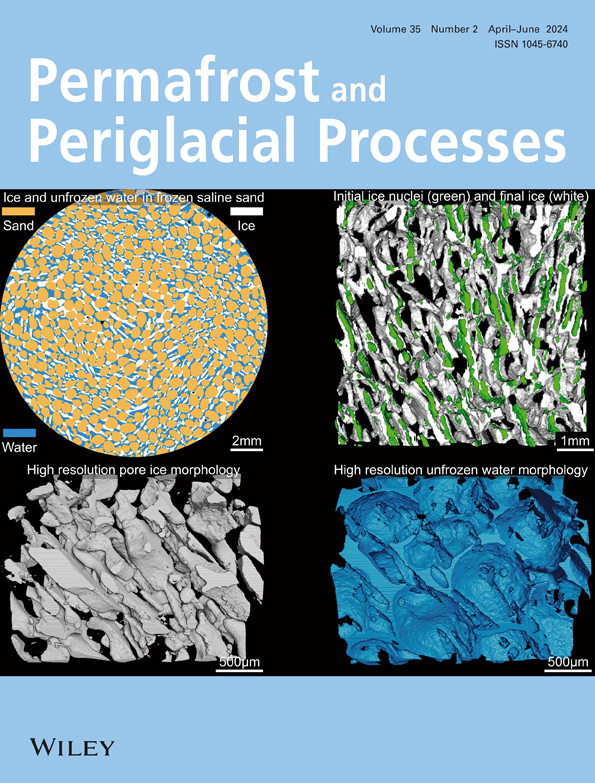东西伯利亚雅库特冰原的硫同位素地球化学
IF 3
3区 地球科学
Q2 GEOGRAPHY, PHYSICAL
引用次数: 0
摘要
硫的稳定同位素比值变化很大,并参与了许多生物地球化学过程,是同位素古环境代用元素中应用最广泛的元素之一,但冰川及其不溶解部分的硫同位素比值仍未得到研究。本研究首先介绍了从东西伯利亚冰骸中回收的可溶性硫酸盐、颗粒有机物(POM)和石质颗粒的硫同位素组成。可溶性硫酸盐主要代表大气中的硫酸盐沉积,在 Zyryanka 和 Batagay 显示出相似的硫同位素范围,而在中雅库特,冰缘硫酸盐更富含 34S,这与东西伯利亚的造山运动和板块地形相一致。鉴于内陆冬季的楔形增长,硫酸盐气溶胶很可能主要来自区域基底岩石的侵蚀和风化,而不是海盐喷雾或生物排放。然而,在单个冰翼内部,可溶性硫酸盐的硫同位素组成差异高达 7‰,这可能反映了硫同位素不同来源区域的相对贡献率的变化。除了硫酸盐的来源之外,上一次冰川期POM和硫酸盐之间更大的硫同位素分馏表明,硫酸盐可能在邻近根区被厌氧还原成硫化物,反之亦然。本文章由计算机程序翻译,如有差异,请以英文原文为准。
Sulfur Isotope Geochemistry of Ice‐Wedges in Yakutia, East Siberia
Sulfur, with its highly varying stable isotope ratio and involvement in numerous biogeochemical processes, is one of the most widely used elements as an isotopic paleoenvironmental proxy, yet the sulfur isotope ratios of ice‐wedges and their insoluble fraction remain unexplored. This study first presents the sulfur isotopic compositions of soluble sulfate, particulate organic matter (POM), and lithic particles recovered from East Siberian ice‐wedges. Soluble sulfate, primarily representing atmospheric sulfate deposition, shows comparable sulfur isotope ranges in Zyryanka and Batagay, while in Central Yakutia, ice‐wedge sulfate is more enriched in 34S, consistent with the orogenic and cratonic terranes in East Siberia. Given the wedge growth during the inland winter, it is likely that sulfate aerosols were derived mainly from erosion and weathering of regional basement rocks rather than from sea salt spray or biogenic emissions. Within individual ice‐wedges, however, the sulfur isotopic composition of soluble sulfate varies by as much as 7‰, possibly reflecting changes in the relative contributions of sulfur‐isotopically distinct source regions. Beyond the origin of sulfate, greater sulfur isotope fractionations between POM and sulfate during the last glaciation suggest that sulfate may have been anaerobically reduced to sulfide and vice versa in the adjacent root zone.
求助全文
通过发布文献求助,成功后即可免费获取论文全文。
去求助
来源期刊
CiteScore
9.70
自引率
8.00%
发文量
43
审稿时长
>12 weeks
期刊介绍:
Permafrost and Periglacial Processes is an international journal dedicated to the rapid publication of scientific and technical papers concerned with earth surface cryogenic processes, landforms and sediments present in a variety of (Sub) Arctic, Antarctic and High Mountain environments. It provides an efficient vehicle of communication amongst those with an interest in the cold, non-glacial geosciences. The focus is on (1) original research based on geomorphological, hydrological, sedimentological, geotechnical and engineering aspects of these areas and (2) original research carried out upon relict features where the objective has been to reconstruct the nature of the processes and/or palaeoenvironments which gave rise to these features, as opposed to purely stratigraphical considerations. The journal also publishes short communications, reviews, discussions and book reviews. The high scientific standard, interdisciplinary character and worldwide representation of PPP are maintained by regional editorial support and a rigorous refereeing system.

 求助内容:
求助内容: 应助结果提醒方式:
应助结果提醒方式:


